MAA303: Audit and Assurance Case Study - Financial Analysis and Risks
VerifiedAdded on 2022/09/08
|9
|1527
|11
Case Study
AI Summary
This case study analyzes the audit and assurance procedures applied to Morris Limited. The student begins by discussing the role of analytical procedures in risk assessment, highlighting the identification of material misstatements and unusual transactions. The importance of professional skepticism in audit planning and execution is then addressed. The determination of materiality, using revenue as a benchmark, is explained. A detailed ratio analysis is presented, comparing 2019 and 2018 financial data, including profitability, liquidity, and debt ratios. The student then interprets the ratio analysis, identifying key areas of concern for the auditors, such as declining gross profit margins, increasing debt, and liquidity issues. The analysis emphasizes the need for auditors to focus on sales revenue, inventory, current liabilities, and the company's loan and trade payables, along with the increasing cost of sales. The analysis is supported by relevant academic references.
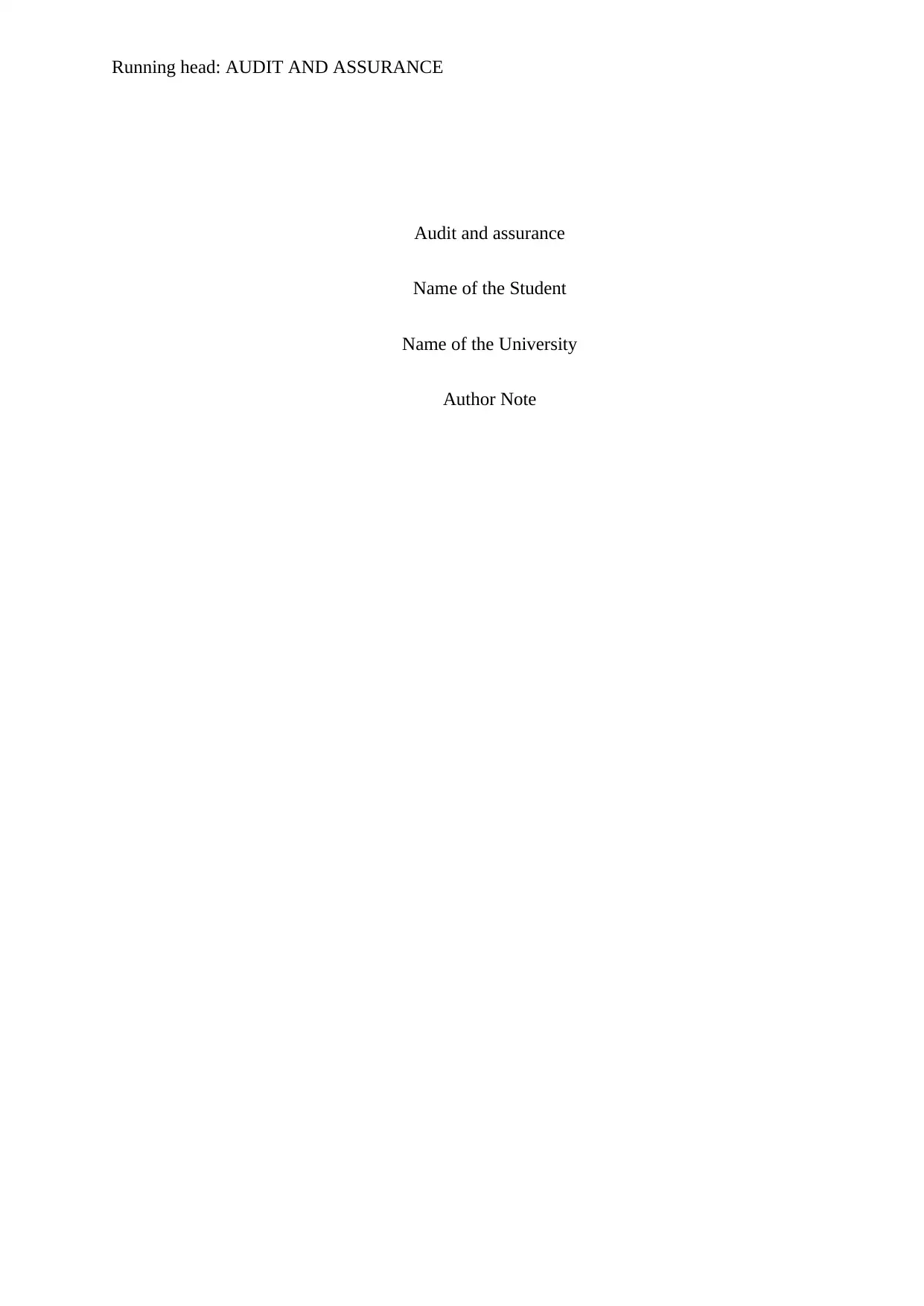
Running head: AUDIT AND ASSURANCE
Audit and assurance
Name of the Student
Name of the University
Author Note
Audit and assurance
Name of the Student
Name of the University
Author Note
Paraphrase This Document
Need a fresh take? Get an instant paraphrase of this document with our AI Paraphraser
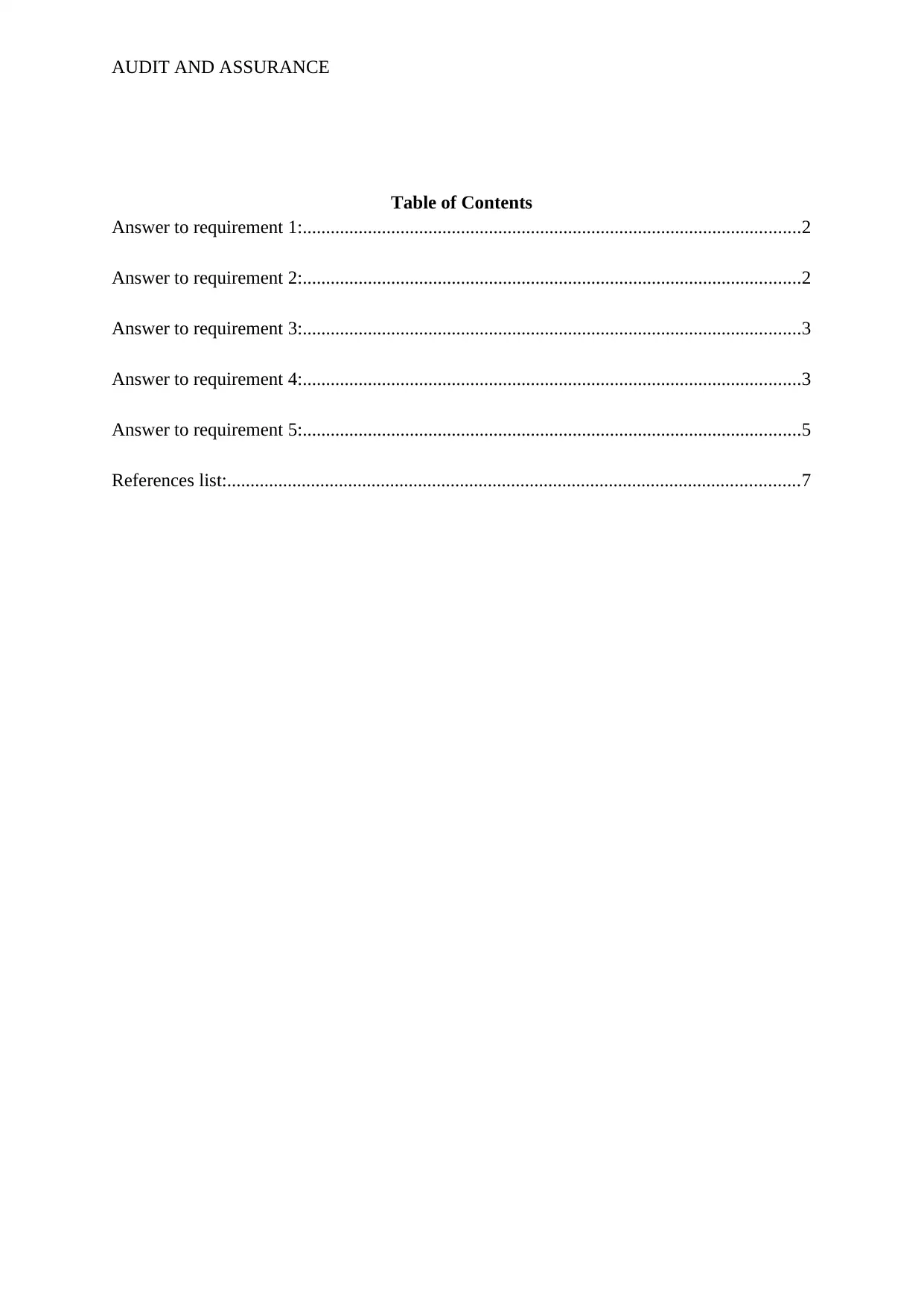
AUDIT AND ASSURANCE
Table of Contents
Answer to requirement 1:...........................................................................................................2
Answer to requirement 2:...........................................................................................................2
Answer to requirement 3:...........................................................................................................3
Answer to requirement 4:...........................................................................................................3
Answer to requirement 5:...........................................................................................................5
References list:...........................................................................................................................7
Table of Contents
Answer to requirement 1:...........................................................................................................2
Answer to requirement 2:...........................................................................................................2
Answer to requirement 3:...........................................................................................................3
Answer to requirement 4:...........................................................................................................3
Answer to requirement 5:...........................................................................................................5
References list:...........................................................................................................................7
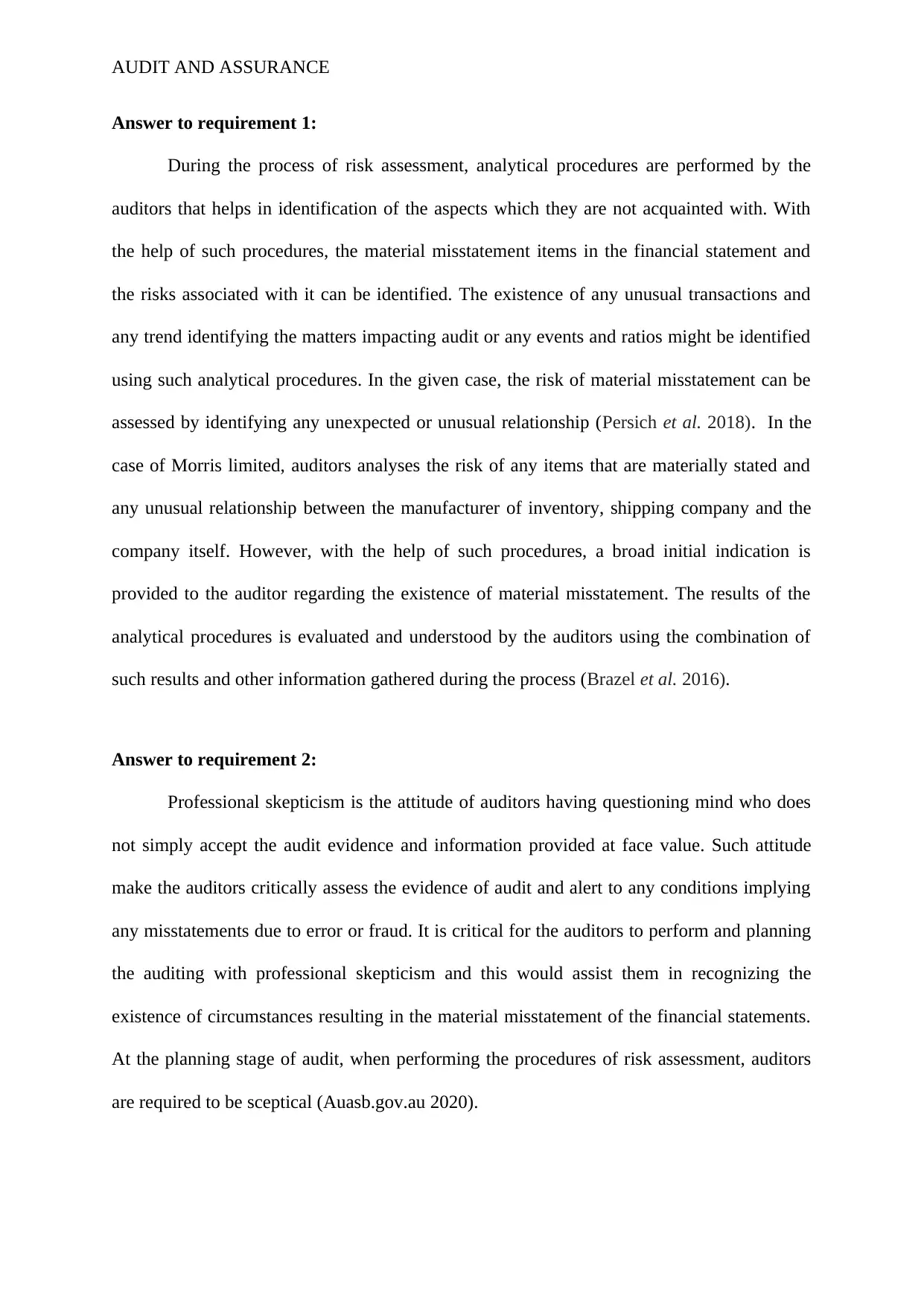
AUDIT AND ASSURANCE
Answer to requirement 1:
During the process of risk assessment, analytical procedures are performed by the
auditors that helps in identification of the aspects which they are not acquainted with. With
the help of such procedures, the material misstatement items in the financial statement and
the risks associated with it can be identified. The existence of any unusual transactions and
any trend identifying the matters impacting audit or any events and ratios might be identified
using such analytical procedures. In the given case, the risk of material misstatement can be
assessed by identifying any unexpected or unusual relationship (Persich et al. 2018). In the
case of Morris limited, auditors analyses the risk of any items that are materially stated and
any unusual relationship between the manufacturer of inventory, shipping company and the
company itself. However, with the help of such procedures, a broad initial indication is
provided to the auditor regarding the existence of material misstatement. The results of the
analytical procedures is evaluated and understood by the auditors using the combination of
such results and other information gathered during the process (Brazel et al. 2016).
Answer to requirement 2:
Professional skepticism is the attitude of auditors having questioning mind who does
not simply accept the audit evidence and information provided at face value. Such attitude
make the auditors critically assess the evidence of audit and alert to any conditions implying
any misstatements due to error or fraud. It is critical for the auditors to perform and planning
the auditing with professional skepticism and this would assist them in recognizing the
existence of circumstances resulting in the material misstatement of the financial statements.
At the planning stage of audit, when performing the procedures of risk assessment, auditors
are required to be sceptical (Auasb.gov.au 2020).
Answer to requirement 1:
During the process of risk assessment, analytical procedures are performed by the
auditors that helps in identification of the aspects which they are not acquainted with. With
the help of such procedures, the material misstatement items in the financial statement and
the risks associated with it can be identified. The existence of any unusual transactions and
any trend identifying the matters impacting audit or any events and ratios might be identified
using such analytical procedures. In the given case, the risk of material misstatement can be
assessed by identifying any unexpected or unusual relationship (Persich et al. 2018). In the
case of Morris limited, auditors analyses the risk of any items that are materially stated and
any unusual relationship between the manufacturer of inventory, shipping company and the
company itself. However, with the help of such procedures, a broad initial indication is
provided to the auditor regarding the existence of material misstatement. The results of the
analytical procedures is evaluated and understood by the auditors using the combination of
such results and other information gathered during the process (Brazel et al. 2016).
Answer to requirement 2:
Professional skepticism is the attitude of auditors having questioning mind who does
not simply accept the audit evidence and information provided at face value. Such attitude
make the auditors critically assess the evidence of audit and alert to any conditions implying
any misstatements due to error or fraud. It is critical for the auditors to perform and planning
the auditing with professional skepticism and this would assist them in recognizing the
existence of circumstances resulting in the material misstatement of the financial statements.
At the planning stage of audit, when performing the procedures of risk assessment, auditors
are required to be sceptical (Auasb.gov.au 2020).
⊘ This is a preview!⊘
Do you want full access?
Subscribe today to unlock all pages.

Trusted by 1+ million students worldwide
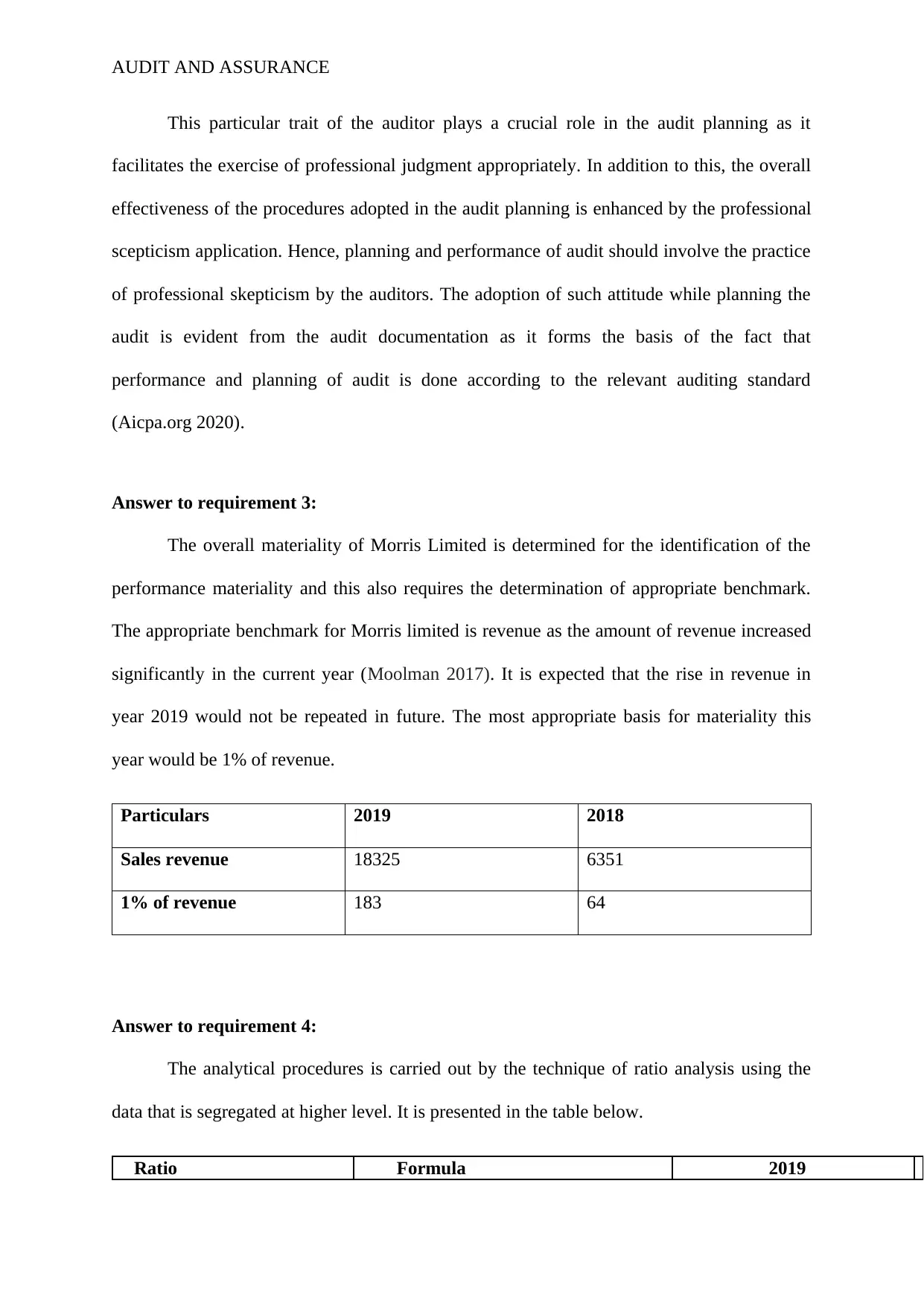
AUDIT AND ASSURANCE
This particular trait of the auditor plays a crucial role in the audit planning as it
facilitates the exercise of professional judgment appropriately. In addition to this, the overall
effectiveness of the procedures adopted in the audit planning is enhanced by the professional
scepticism application. Hence, planning and performance of audit should involve the practice
of professional skepticism by the auditors. The adoption of such attitude while planning the
audit is evident from the audit documentation as it forms the basis of the fact that
performance and planning of audit is done according to the relevant auditing standard
(Aicpa.org 2020).
Answer to requirement 3:
The overall materiality of Morris Limited is determined for the identification of the
performance materiality and this also requires the determination of appropriate benchmark.
The appropriate benchmark for Morris limited is revenue as the amount of revenue increased
significantly in the current year (Moolman 2017). It is expected that the rise in revenue in
year 2019 would not be repeated in future. The most appropriate basis for materiality this
year would be 1% of revenue.
Particulars 2019 2018
Sales revenue 18325 6351
1% of revenue 183 64
Answer to requirement 4:
The analytical procedures is carried out by the technique of ratio analysis using the
data that is segregated at higher level. It is presented in the table below.
Ratio Formula 2019
This particular trait of the auditor plays a crucial role in the audit planning as it
facilitates the exercise of professional judgment appropriately. In addition to this, the overall
effectiveness of the procedures adopted in the audit planning is enhanced by the professional
scepticism application. Hence, planning and performance of audit should involve the practice
of professional skepticism by the auditors. The adoption of such attitude while planning the
audit is evident from the audit documentation as it forms the basis of the fact that
performance and planning of audit is done according to the relevant auditing standard
(Aicpa.org 2020).
Answer to requirement 3:
The overall materiality of Morris Limited is determined for the identification of the
performance materiality and this also requires the determination of appropriate benchmark.
The appropriate benchmark for Morris limited is revenue as the amount of revenue increased
significantly in the current year (Moolman 2017). It is expected that the rise in revenue in
year 2019 would not be repeated in future. The most appropriate basis for materiality this
year would be 1% of revenue.
Particulars 2019 2018
Sales revenue 18325 6351
1% of revenue 183 64
Answer to requirement 4:
The analytical procedures is carried out by the technique of ratio analysis using the
data that is segregated at higher level. It is presented in the table below.
Ratio Formula 2019
Paraphrase This Document
Need a fresh take? Get an instant paraphrase of this document with our AI Paraphraser
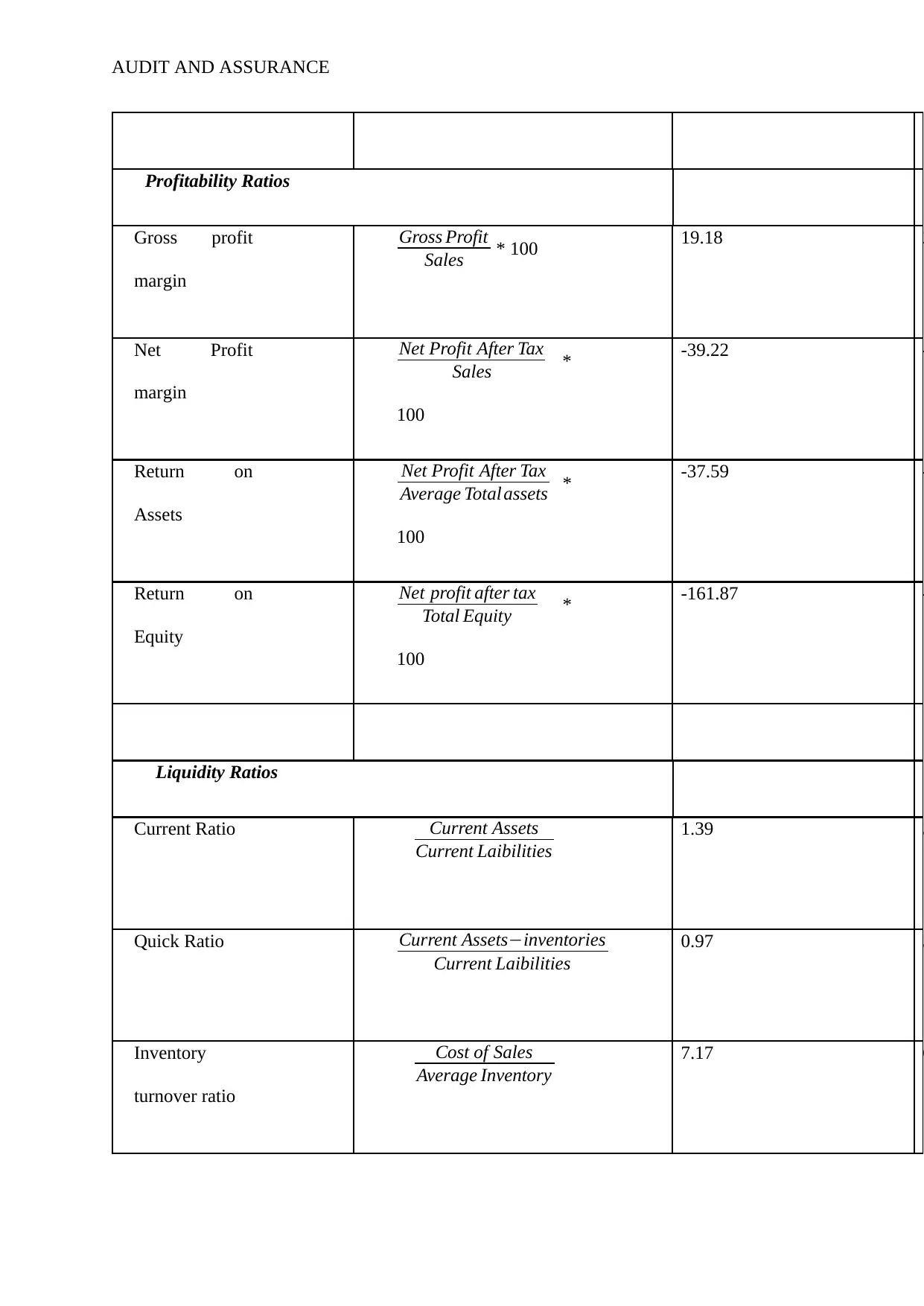
AUDIT AND ASSURANCE
Profitability Ratios
Gross profit
margin
Gross Profit
Sales * 100 19.18 2
Net Profit
margin
Net Profit After Tax
Sales *
100
-39.22 -
Return on
Assets
Net Profit After Tax
Average Total assets *
100
-37.59 -
Return on
Equity
Net profit after tax
Total Equity *
100
-161.87 -
Liquidity Ratios
Current Ratio Current Assets
Current Laibilities
1.39 3
Quick Ratio Current Assets−inventories
Current Laibilities
0.97 3
Inventory
turnover ratio
Cost of Sales
Average Inventory
7.17 6
Profitability Ratios
Gross profit
margin
Gross Profit
Sales * 100 19.18 2
Net Profit
margin
Net Profit After Tax
Sales *
100
-39.22 -
Return on
Assets
Net Profit After Tax
Average Total assets *
100
-37.59 -
Return on
Equity
Net profit after tax
Total Equity *
100
-161.87 -
Liquidity Ratios
Current Ratio Current Assets
Current Laibilities
1.39 3
Quick Ratio Current Assets−inventories
Current Laibilities
0.97 3
Inventory
turnover ratio
Cost of Sales
Average Inventory
7.17 6
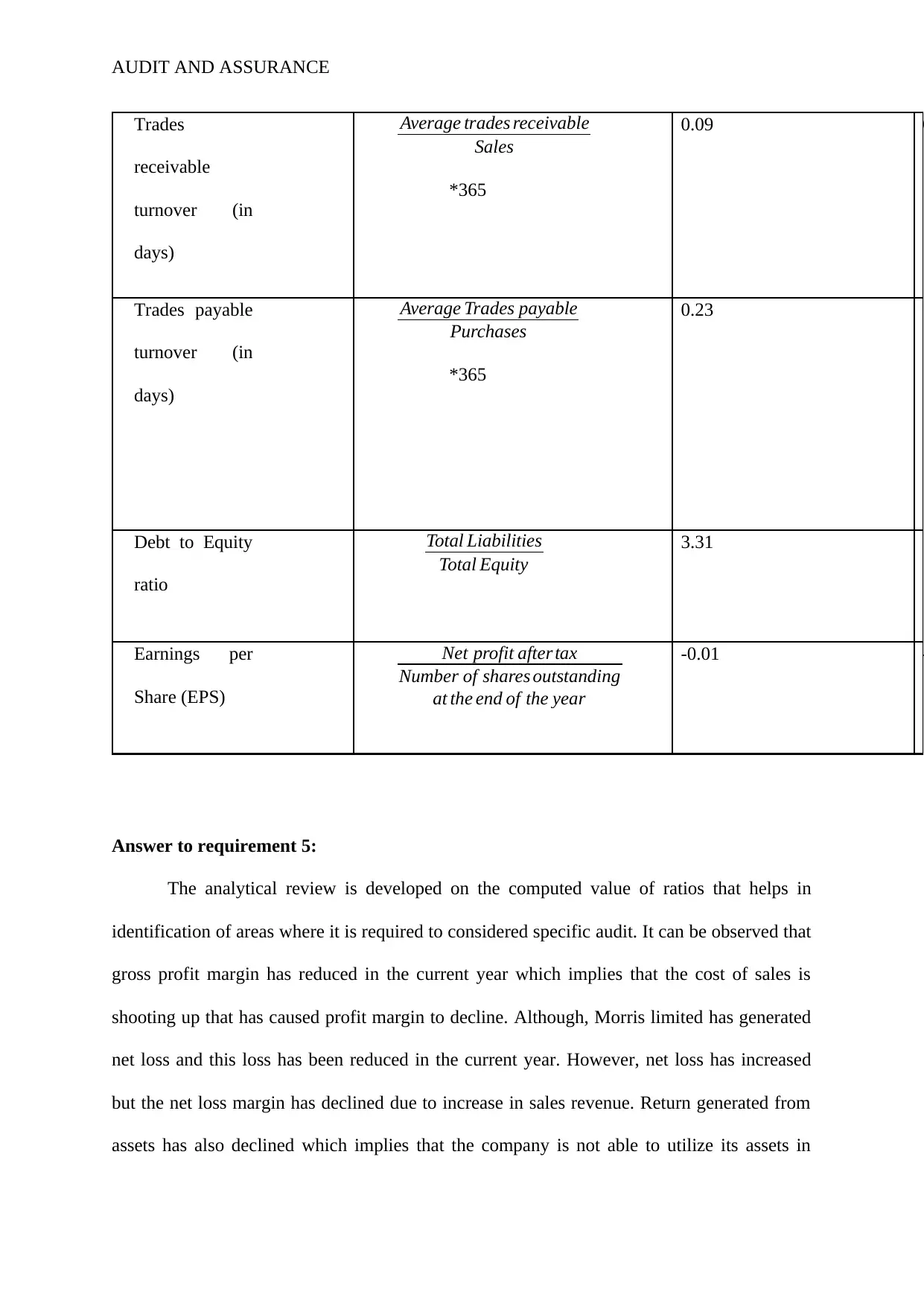
AUDIT AND ASSURANCE
Trades
receivable
turnover (in
days)
Average trades receivable
Sales
*365
0.09 0
Trades payable
turnover (in
days)
Average Trades payable
Purchases
*365
0.23
Debt to Equity
ratio
Total Liabilities
Total Equity
3.31
Earnings per
Share (EPS)
Net profit after tax
Number of shares outstanding
at the end of the year
-0.01 -
Answer to requirement 5:
The analytical review is developed on the computed value of ratios that helps in
identification of areas where it is required to considered specific audit. It can be observed that
gross profit margin has reduced in the current year which implies that the cost of sales is
shooting up that has caused profit margin to decline. Although, Morris limited has generated
net loss and this loss has been reduced in the current year. However, net loss has increased
but the net loss margin has declined due to increase in sales revenue. Return generated from
assets has also declined which implies that the company is not able to utilize its assets in
Trades
receivable
turnover (in
days)
Average trades receivable
Sales
*365
0.09 0
Trades payable
turnover (in
days)
Average Trades payable
Purchases
*365
0.23
Debt to Equity
ratio
Total Liabilities
Total Equity
3.31
Earnings per
Share (EPS)
Net profit after tax
Number of shares outstanding
at the end of the year
-0.01 -
Answer to requirement 5:
The analytical review is developed on the computed value of ratios that helps in
identification of areas where it is required to considered specific audit. It can be observed that
gross profit margin has reduced in the current year which implies that the cost of sales is
shooting up that has caused profit margin to decline. Although, Morris limited has generated
net loss and this loss has been reduced in the current year. However, net loss has increased
but the net loss margin has declined due to increase in sales revenue. Return generated from
assets has also declined which implies that the company is not able to utilize its assets in
⊘ This is a preview!⊘
Do you want full access?
Subscribe today to unlock all pages.

Trusted by 1+ million students worldwide
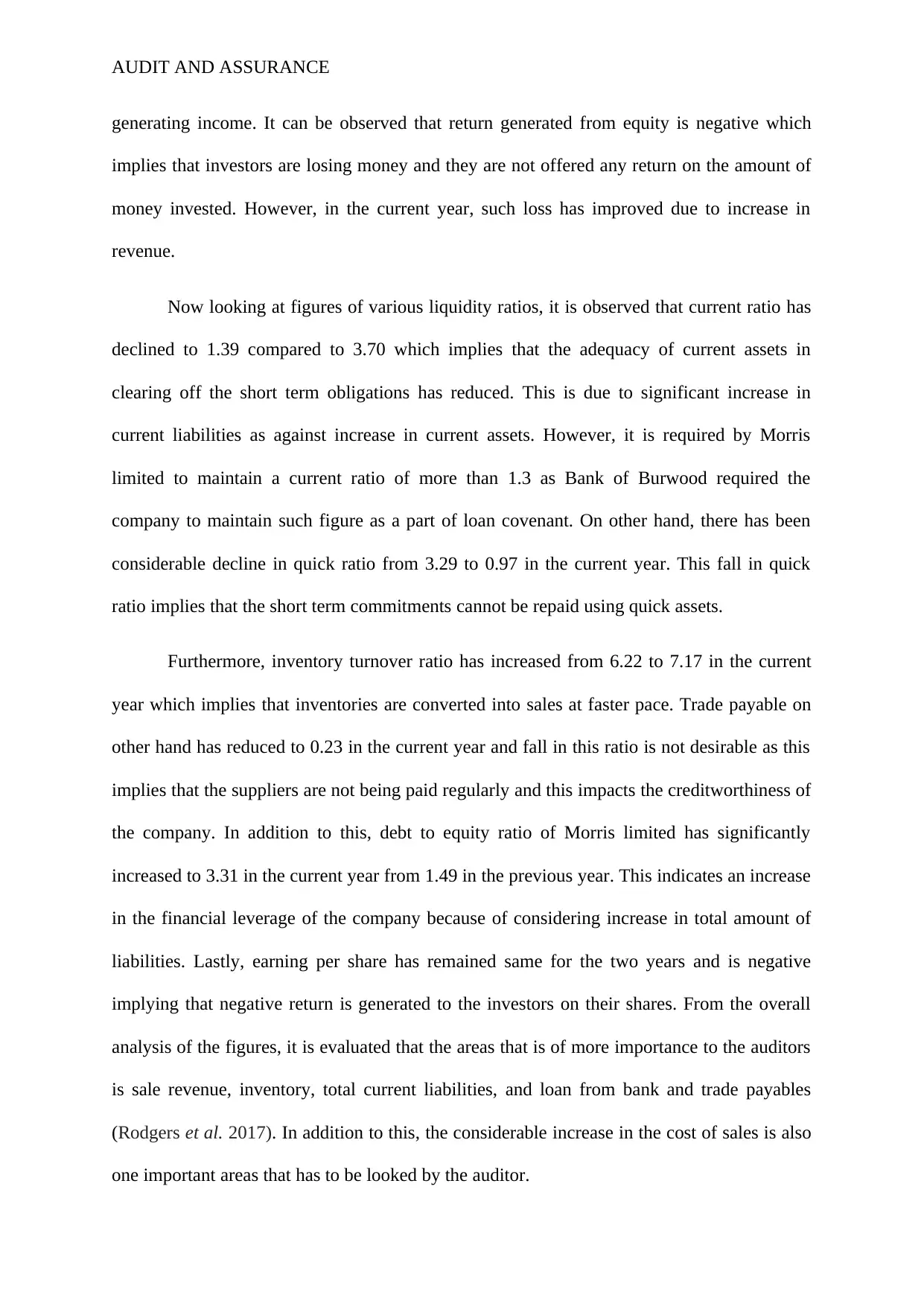
AUDIT AND ASSURANCE
generating income. It can be observed that return generated from equity is negative which
implies that investors are losing money and they are not offered any return on the amount of
money invested. However, in the current year, such loss has improved due to increase in
revenue.
Now looking at figures of various liquidity ratios, it is observed that current ratio has
declined to 1.39 compared to 3.70 which implies that the adequacy of current assets in
clearing off the short term obligations has reduced. This is due to significant increase in
current liabilities as against increase in current assets. However, it is required by Morris
limited to maintain a current ratio of more than 1.3 as Bank of Burwood required the
company to maintain such figure as a part of loan covenant. On other hand, there has been
considerable decline in quick ratio from 3.29 to 0.97 in the current year. This fall in quick
ratio implies that the short term commitments cannot be repaid using quick assets.
Furthermore, inventory turnover ratio has increased from 6.22 to 7.17 in the current
year which implies that inventories are converted into sales at faster pace. Trade payable on
other hand has reduced to 0.23 in the current year and fall in this ratio is not desirable as this
implies that the suppliers are not being paid regularly and this impacts the creditworthiness of
the company. In addition to this, debt to equity ratio of Morris limited has significantly
increased to 3.31 in the current year from 1.49 in the previous year. This indicates an increase
in the financial leverage of the company because of considering increase in total amount of
liabilities. Lastly, earning per share has remained same for the two years and is negative
implying that negative return is generated to the investors on their shares. From the overall
analysis of the figures, it is evaluated that the areas that is of more importance to the auditors
is sale revenue, inventory, total current liabilities, and loan from bank and trade payables
(Rodgers et al. 2017). In addition to this, the considerable increase in the cost of sales is also
one important areas that has to be looked by the auditor.
generating income. It can be observed that return generated from equity is negative which
implies that investors are losing money and they are not offered any return on the amount of
money invested. However, in the current year, such loss has improved due to increase in
revenue.
Now looking at figures of various liquidity ratios, it is observed that current ratio has
declined to 1.39 compared to 3.70 which implies that the adequacy of current assets in
clearing off the short term obligations has reduced. This is due to significant increase in
current liabilities as against increase in current assets. However, it is required by Morris
limited to maintain a current ratio of more than 1.3 as Bank of Burwood required the
company to maintain such figure as a part of loan covenant. On other hand, there has been
considerable decline in quick ratio from 3.29 to 0.97 in the current year. This fall in quick
ratio implies that the short term commitments cannot be repaid using quick assets.
Furthermore, inventory turnover ratio has increased from 6.22 to 7.17 in the current
year which implies that inventories are converted into sales at faster pace. Trade payable on
other hand has reduced to 0.23 in the current year and fall in this ratio is not desirable as this
implies that the suppliers are not being paid regularly and this impacts the creditworthiness of
the company. In addition to this, debt to equity ratio of Morris limited has significantly
increased to 3.31 in the current year from 1.49 in the previous year. This indicates an increase
in the financial leverage of the company because of considering increase in total amount of
liabilities. Lastly, earning per share has remained same for the two years and is negative
implying that negative return is generated to the investors on their shares. From the overall
analysis of the figures, it is evaluated that the areas that is of more importance to the auditors
is sale revenue, inventory, total current liabilities, and loan from bank and trade payables
(Rodgers et al. 2017). In addition to this, the considerable increase in the cost of sales is also
one important areas that has to be looked by the auditor.
Paraphrase This Document
Need a fresh take? Get an instant paraphrase of this document with our AI Paraphraser
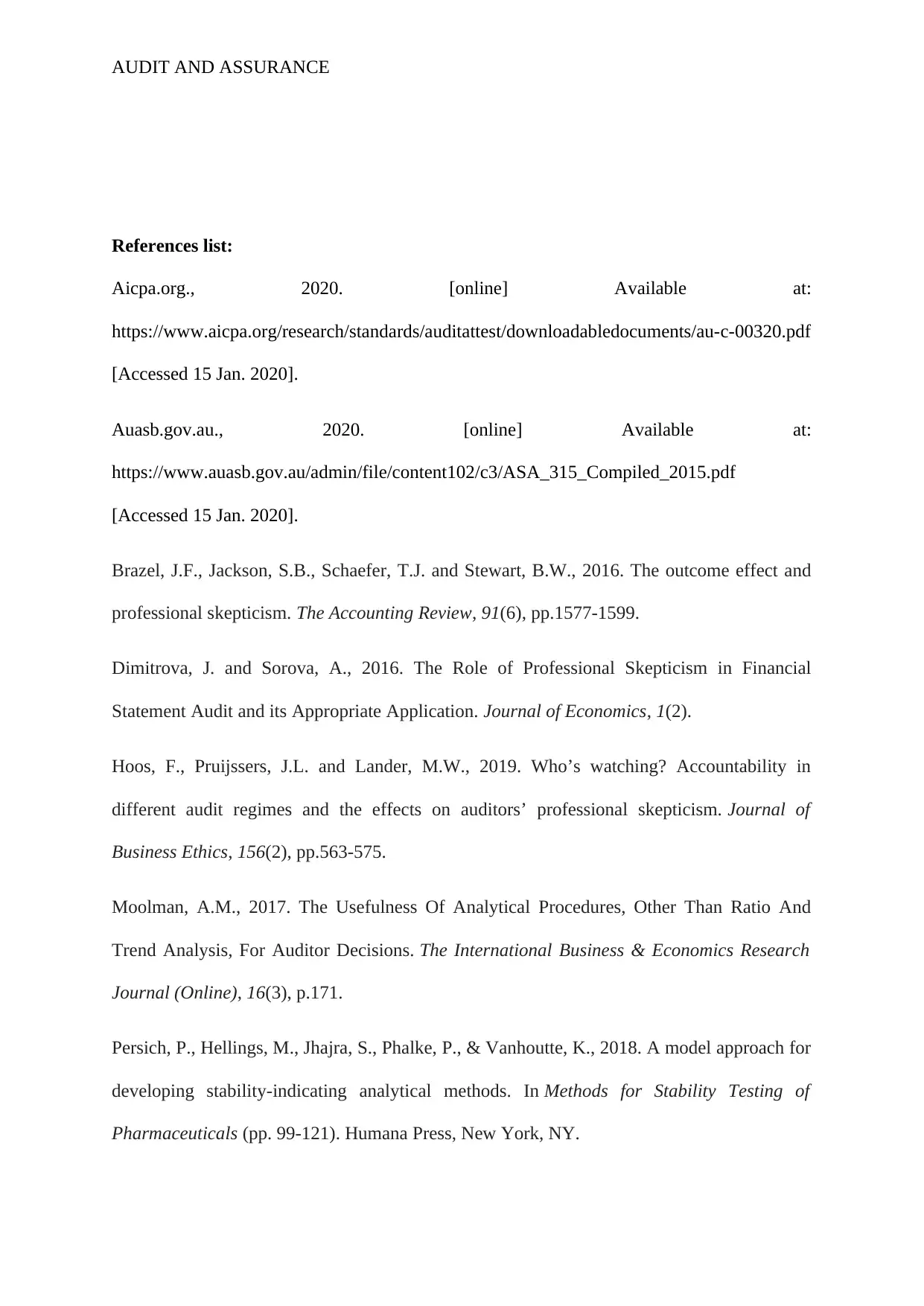
AUDIT AND ASSURANCE
References list:
Aicpa.org., 2020. [online] Available at:
https://www.aicpa.org/research/standards/auditattest/downloadabledocuments/au-c-00320.pdf
[Accessed 15 Jan. 2020].
Auasb.gov.au., 2020. [online] Available at:
https://www.auasb.gov.au/admin/file/content102/c3/ASA_315_Compiled_2015.pdf
[Accessed 15 Jan. 2020].
Brazel, J.F., Jackson, S.B., Schaefer, T.J. and Stewart, B.W., 2016. The outcome effect and
professional skepticism. The Accounting Review, 91(6), pp.1577-1599.
Dimitrova, J. and Sorova, A., 2016. The Role of Professional Skepticism in Financial
Statement Audit and its Appropriate Application. Journal of Economics, 1(2).
Hoos, F., Pruijssers, J.L. and Lander, M.W., 2019. Who’s watching? Accountability in
different audit regimes and the effects on auditors’ professional skepticism. Journal of
Business Ethics, 156(2), pp.563-575.
Moolman, A.M., 2017. The Usefulness Of Analytical Procedures, Other Than Ratio And
Trend Analysis, For Auditor Decisions. The International Business & Economics Research
Journal (Online), 16(3), p.171.
Persich, P., Hellings, M., Jhajra, S., Phalke, P., & Vanhoutte, K., 2018. A model approach for
developing stability-indicating analytical methods. In Methods for Stability Testing of
Pharmaceuticals (pp. 99-121). Humana Press, New York, NY.
References list:
Aicpa.org., 2020. [online] Available at:
https://www.aicpa.org/research/standards/auditattest/downloadabledocuments/au-c-00320.pdf
[Accessed 15 Jan. 2020].
Auasb.gov.au., 2020. [online] Available at:
https://www.auasb.gov.au/admin/file/content102/c3/ASA_315_Compiled_2015.pdf
[Accessed 15 Jan. 2020].
Brazel, J.F., Jackson, S.B., Schaefer, T.J. and Stewart, B.W., 2016. The outcome effect and
professional skepticism. The Accounting Review, 91(6), pp.1577-1599.
Dimitrova, J. and Sorova, A., 2016. The Role of Professional Skepticism in Financial
Statement Audit and its Appropriate Application. Journal of Economics, 1(2).
Hoos, F., Pruijssers, J.L. and Lander, M.W., 2019. Who’s watching? Accountability in
different audit regimes and the effects on auditors’ professional skepticism. Journal of
Business Ethics, 156(2), pp.563-575.
Moolman, A.M., 2017. The Usefulness Of Analytical Procedures, Other Than Ratio And
Trend Analysis, For Auditor Decisions. The International Business & Economics Research
Journal (Online), 16(3), p.171.
Persich, P., Hellings, M., Jhajra, S., Phalke, P., & Vanhoutte, K., 2018. A model approach for
developing stability-indicating analytical methods. In Methods for Stability Testing of
Pharmaceuticals (pp. 99-121). Humana Press, New York, NY.
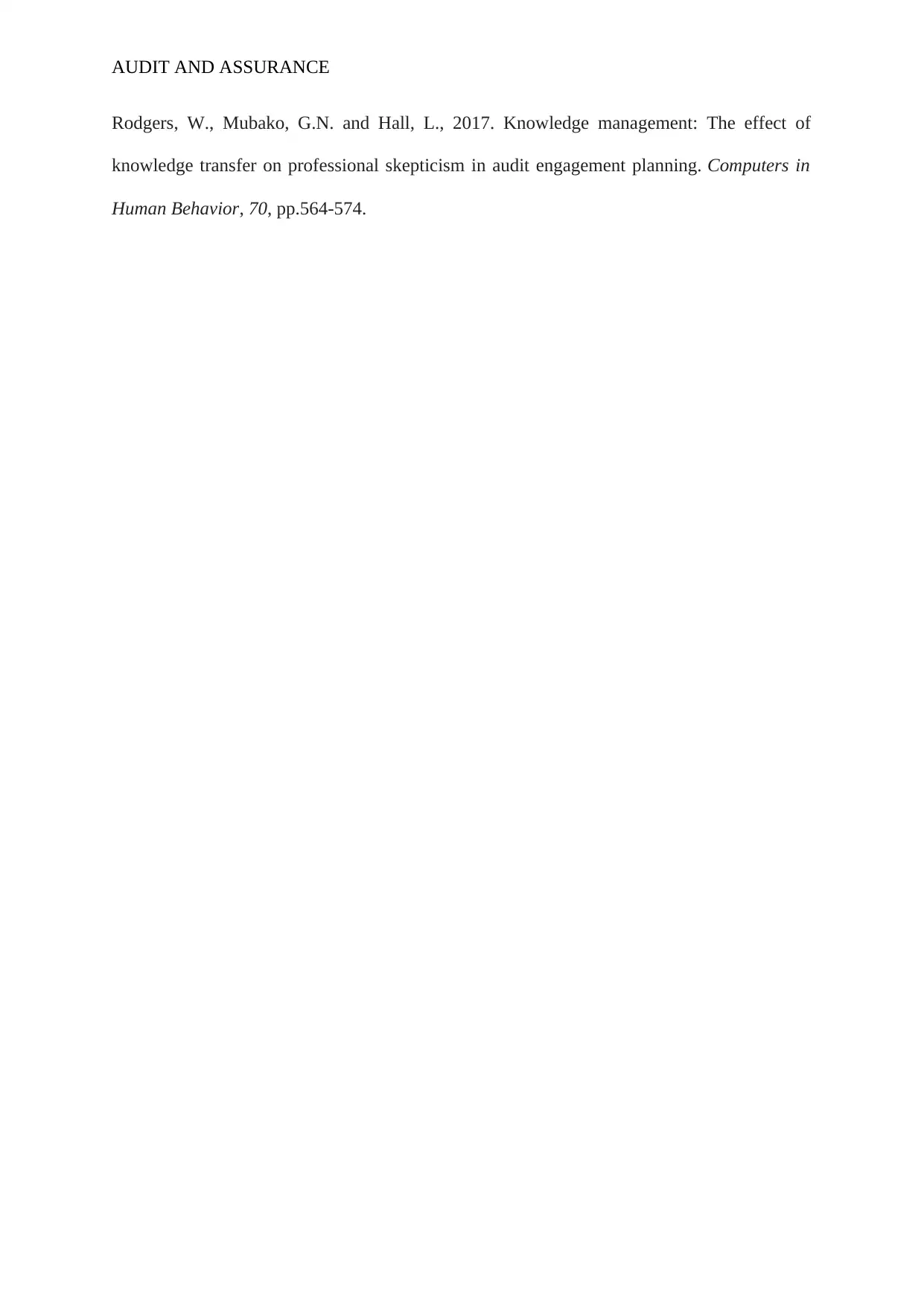
AUDIT AND ASSURANCE
Rodgers, W., Mubako, G.N. and Hall, L., 2017. Knowledge management: The effect of
knowledge transfer on professional skepticism in audit engagement planning. Computers in
Human Behavior, 70, pp.564-574.
Rodgers, W., Mubako, G.N. and Hall, L., 2017. Knowledge management: The effect of
knowledge transfer on professional skepticism in audit engagement planning. Computers in
Human Behavior, 70, pp.564-574.
⊘ This is a preview!⊘
Do you want full access?
Subscribe today to unlock all pages.

Trusted by 1+ million students worldwide
1 out of 9
Related Documents
Your All-in-One AI-Powered Toolkit for Academic Success.
+13062052269
info@desklib.com
Available 24*7 on WhatsApp / Email
![[object Object]](/_next/static/media/star-bottom.7253800d.svg)
Unlock your academic potential
Copyright © 2020–2025 A2Z Services. All Rights Reserved. Developed and managed by ZUCOL.





